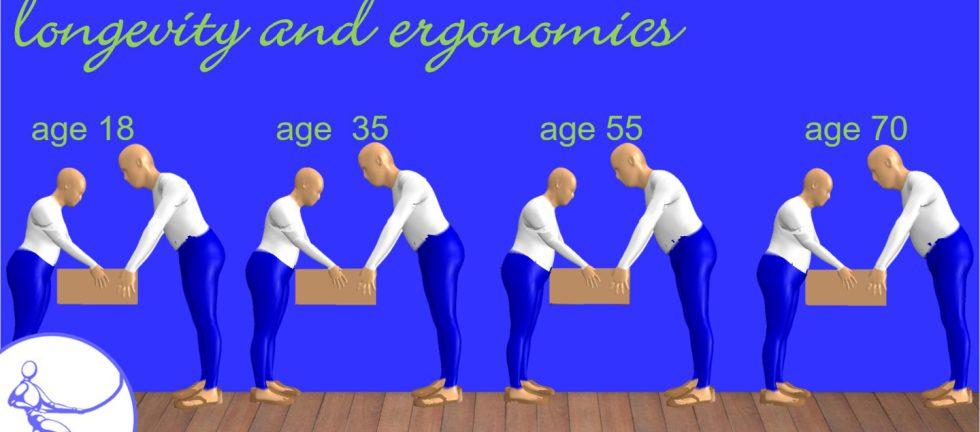Over the past 25+ years, I’ve shared articles about issues that were relevant to me at specific times in my life: pregnancy, ergonomics with (and for) children, pets, camping, cottaging, travel, and so on. When I meet new people at business functions, those who have been reading our newsletters and blogs often tell me that they feel like they know me!
I recently read a book by Dr. Howard Luks called “Longevity Simplified” that resonated with me at this point in my life. He talks about seven keys to prolonging healthy life. Dr. Luks’ advice was very common-sense, backed up with science: maintain a healthy body weight, sleep well, socialize, eat well, have purpose. Two pertained to exercise:
“Move often, throughout the day.” We’ve been promoting this practice for workers who sit or stand still, for years. In fact, we offer an e-learning program intended to introduce sit/stand workstations effectively, and we’ve been helping several clients with their workplace stretch and strength programs. I appreciated that Dr. Luks promoted frequent exercise and emphasized that this didn’t need to mean “getting sweaty”. An extra couple of flights of stairs, or a longer walk from your parking spot can help you meet your daily activity goals. I also liked that he encouraged us to “move occasionally with ferocious intent”. I can visualize what that means for me.
“Push and pull heavy things.” You can imagine that I read that line two or three times. As an ergonomist, I try to discourage people from pushing and pulling heavy things! More accurately, I try to encourage companies to make heavy things easier to push and pull.
But what Dr. Luks was trying to encourage with this statement was resistance exercise. If you can maintain muscle strength as you age, you’ll burn fuel (food) more efficiently, and you’ll be less likely to stumble and fall. Our bodies do tend to change with age; I used our biomechanics software (University of Michigan’s 3D Static Strength Prediction Program) to show, above, how our bodies change through our work lives. If you look closely at the image above, you’ll see subtle changes in the shape of the abdomen, arms, and legs, as the “50th percentile” (average) worker ages. These changes can be counteracted with resistance, or strength, training.
Ergonomists like to think of strength training as shifting the balance between capability and demands. If the job requirements approach your strength, you could be at high risk of injury. To avoid injury, we can reduce the demands, or increase your capability. An ergonomist can do an assessment to evaluate how work demands compare with worker capabilities. Ergonomics (Risk) Assessment (EA) – Taylor’d Ergonomics (taylordergo.com) Our recommendations usually focus on modifying work demands.
Sometimes people ask about the difference between work demands and “exercise”. Isn’t heavy work good for people? Dr. Luks points out that strength-training, ideally, should involve working at 70% of your maximum strength, for 5-7 repetitions, or at a lower effort, but repeating until failure. His guidelines for resistance training are fairly specific.
This is not the type of “exercise” that people are getting in the workplace. When we exercise, we can stop when we need to stop, because we set the load ourselves. When we exercise “to failure” we rest immediately afterwards. In the workplace, we rarely have that level of control. The effort to “push heavy things” at work may easily exceed our capability and cause an acute injury. It’s true probably that a small portion of employees get sufficient “exercise” while at work, but the number is very small. Perhaps only fitness instructors are getting all three components: strength, cardio, and balance/mobility exercise. The rest of us need to make an effort to seek out the missing components.
Dr. Luks reports that just one hour per week of resistance exercise reduces the risk of death, and delays the onset of dementia, heart disease, diabetes, and more. Sign me up! Seriously. I intend to follow his advice to “sit and stand 10 times” before I take a seat, and I’ll add in calf raises and maybe even push-ups for good measure. And I also vow to work on balance exercises every day.
I’m in my fifties now, so dementia is very much on my mind. (Pun intended.) I could probably cost-justify taking time out of my day for exercise, simply based on how much time I’d save if I could just remember how I organized my documents, and where I put my reading glasses. But perhaps the most appealing part of Dr. Luks’ approach is that it doesn’t “cost” a dime. His advice can be implemented in the food, sleep, and movement decisions that we make, a thousand times a day. Of course, making 1000 good decisions every day could take a monumental total effort.
If you’re thinking about some mid-year resolutions, I do recommend Dr. Luks’ book. It’s reassuring to think that we have some control over the way we age. Now, if I can remember the password, I’ll share this article on our blog….


